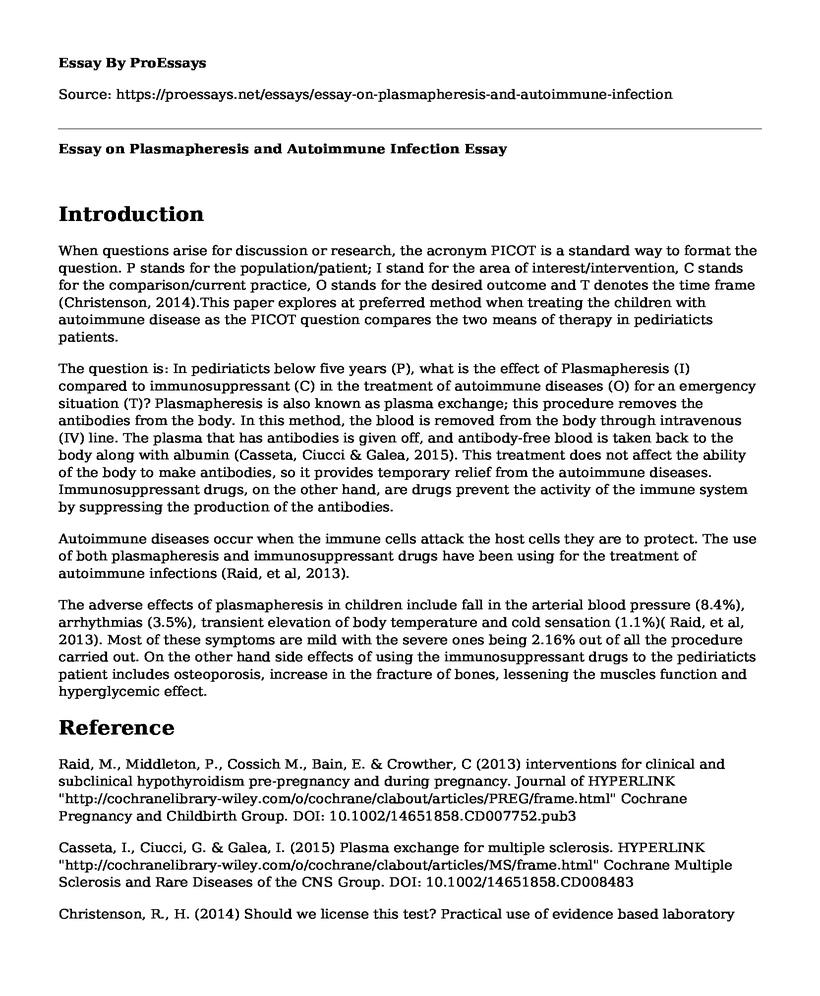Introduction
When questions arise for discussion or research, the acronym PICOT is a standard way to format the question. P stands for the population/patient; I stand for the area of interest/intervention, C stands for the comparison/current practice, O stands for the desired outcome and T denotes the time frame (Christenson, 2014).This paper explores at preferred method when treating the children with autoimmune disease as the PICOT question compares the two means of therapy in pediriaticts patients.
The question is: In pediriaticts below five years (P), what is the effect of Plasmapheresis (I) compared to immunosuppressant (C) in the treatment of autoimmune diseases (O) for an emergency situation (T)? Plasmapheresis is also known as plasma exchange; this procedure removes the antibodies from the body. In this method, the blood is removed from the body through intravenous (IV) line. The plasma that has antibodies is given off, and antibody-free blood is taken back to the body along with albumin (Casseta, Ciucci & Galea, 2015). This treatment does not affect the ability of the body to make antibodies, so it provides temporary relief from the autoimmune diseases. Immunosuppressant drugs, on the other hand, are drugs prevent the activity of the immune system by suppressing the production of the antibodies.
Autoimmune diseases occur when the immune cells attack the host cells they are to protect. The use of both plasmapheresis and immunosuppressant drugs have been using for the treatment of autoimmune infections (Raid, et al, 2013).
The adverse effects of plasmapheresis in children include fall in the arterial blood pressure (8.4%), arrhythmias (3.5%), transient elevation of body temperature and cold sensation (1.1%)( Raid, et al, 2013). Most of these symptoms are mild with the severe ones being 2.16% out of all the procedure carried out. On the other hand side effects of using the immunosuppressant drugs to the pediriaticts patient includes osteoporosis, increase in the fracture of bones, lessening the muscles function and hyperglycemic effect.
Reference
Raid, M., Middleton, P., Cossich M., Bain, E. & Crowther, C (2013) interventions for clinical and subclinical hypothyroidism pre-pregnancy and during pregnancy. Journal of HYPERLINK "http://cochranelibrary-wiley.com/o/cochrane/clabout/articles/PREG/frame.html" Cochrane Pregnancy and Childbirth Group. DOI: 10.1002/14651858.CD007752.pub3
Casseta, I., Ciucci, G. & Galea, I. (2015) Plasma exchange for multiple sclerosis. HYPERLINK "http://cochranelibrary-wiley.com/o/cochrane/clabout/articles/MS/frame.html" Cochrane Multiple Sclerosis and Rare Diseases of the CNS Group. DOI: 10.1002/14651858.CD008483
Christenson, R., H. (2014) Should we license this test? Practical use of evidence based laboratory
medicine (EBLM) technique. The Cochrane Central Register of Controlled Trials (CENTRAL) . (23)70, 70-70.
Cite this page
Essay on Plasmapheresis and Autoimmune Infection. (2022, Apr 07). Retrieved from https://proessays.net/essays/essay-on-plasmapheresis-and-autoimmune-infection
If you are the original author of this essay and no longer wish to have it published on the ProEssays website, please click below to request its removal:
- Paper Example on Elderly Caregiving
- Evaluating Performance Measures in Nursing Homes Paper Example
- Essay Sample on HIV and AIDS in the US
- Norrie Genetic Disease Paper Example
- The "Narcissism" Assessment and Public Health Leadership Paper Example
- Dr. Sebi: Naturalist, Herbalist, Pathologist, & Biochemist - Research Paper
- Biography Sample on Jane Addams: Champion of Peace, Philanthropy, Work Ethic







